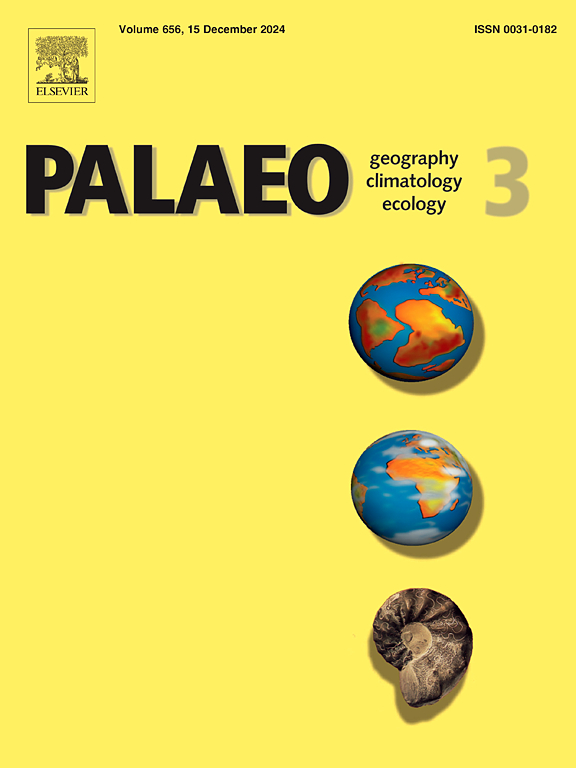New model for estimating trophic position in mammalian carnivores based on bone collagen individual amino acids nitrogen stable isotopes
IF 2.7
2区 地球科学
Q2 GEOGRAPHY, PHYSICAL
Palaeogeography, Palaeoclimatology, Palaeoecology
Pub Date : 2025-05-19
DOI:10.1016/j.palaeo.2025.113040
引用次数: 0
Abstract
Trophic position, or the level occupied by an organism in the food chain, is a key characteristic for understanding its role in the recent or past ecosystem. Nitrogen stable isotopes in selected amino acids of bone collagen, in particular in the glutamate and phenylalanine, allow for quantification of the trophic position in fossils and thus, for reconstruction of the ecological history of species and landscapes. Applying this method for carnivorous mammals was limited until now due to the lack of a key parameter, the trophic discrimination factor (TDF) for collagen, representing an isotopic shift in amino acids from prey bone collagen to carnivore bone collagen. In this study, we determined this parameter in two carnivorans: the modern wolf and the Pleistocene cave hyena. We measured the glutamate and phenylalanine δ15N values in bone collagen of these carnivores and their prey, applying five models to estimate the mean diet. We proposed a new model of calculating the TDF for collagen-based data, with herbivores regarded as a baseline level. We found collagen–to–collagen glutamate-phenylalanine TDF in both studied carnivorans and in all models of the mean diet similar to each other, +4.8 ‰ on average. This value is lower than that determined previously in invertebrate proteins or in plant–to–vertebrate tissue systems. Our results allow for more accurate reconstruction of trophic position in carnivores, including paleontological and archaeological materials where bone collagen is the only available tissue. We applied our new herbivore model and collagen-based TDF to re-asses the trophic structure of an exemplary Late Pleistocene assemblage, and found that the Upper Paleolithic humans at this site occupied a higher trophic position than previously determined.
基于骨胶原单个氨基酸氮稳定同位素估算哺乳动物营养地位的新模型
营养位置,或生物体在食物链中所占据的水平,是理解其在最近或过去的生态系统中的作用的关键特征。骨胶原中特定氨基酸中的氮稳定同位素,特别是谷氨酸和苯丙氨酸,可以量化化石中的营养位置,从而重建物种和景观的生态历史。由于缺乏胶原蛋白的营养区分因子(TDF)这一关键参数,该方法在食肉哺乳动物中的应用受到限制,该参数代表了从猎物骨胶原到食肉动物骨胶原氨基酸的同位素变化。在这项研究中,我们确定了两种食肉动物的这个参数:现代狼和更新世洞穴鬣狗。我们测量了这些食肉动物及其猎物骨胶原中谷氨酸和苯丙氨酸的δ15N值,并应用五种模型来估计平均饮食。我们提出了一个基于胶原蛋白的数据计算TDF的新模型,以食草动物作为基线水平。我们发现胶原-胶原谷氨酸-苯丙氨酸TDF在两种研究的食肉动物和所有平均饮食模型中彼此相似,平均为+4.8‰。这个值低于以前在无脊椎动物蛋白质或植物-脊椎动物组织系统中确定的值。我们的结果允许更准确地重建食肉动物的营养位置,包括古生物和考古材料,骨胶原蛋白是唯一可用的组织。我们应用新的食草动物模型和基于胶原蛋白的TDF重新评估了一个典型的晚更新世组合的营养结构,发现该地点的旧石器时代晚期人类占据了比先前确定的更高的营养地位。
本文章由计算机程序翻译,如有差异,请以英文原文为准。
求助全文
约1分钟内获得全文
求助全文
来源期刊
CiteScore
5.90
自引率
10.00%
发文量
398
审稿时长
3.8 months
期刊介绍:
Palaeogeography, Palaeoclimatology, Palaeoecology is an international medium for the publication of high quality and multidisciplinary, original studies and comprehensive reviews in the field of palaeo-environmental geology. The journal aims at bringing together data with global implications from research in the many different disciplines involved in palaeo-environmental investigations.
By cutting across the boundaries of established sciences, it provides an interdisciplinary forum where issues of general interest can be discussed.

 求助内容:
求助内容: 应助结果提醒方式:
应助结果提醒方式:


